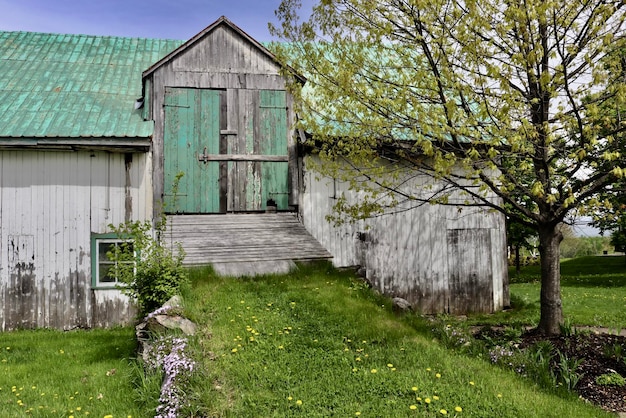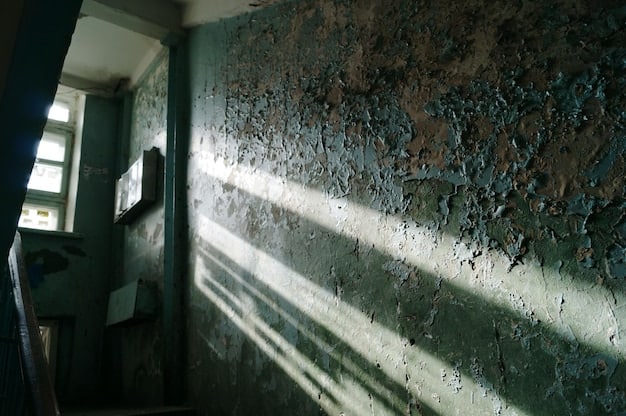Investing in Fixer-Uppers: Risks, Rewards, and Profit Maximization

Investing in fixer-uppers can be a lucrative real estate venture, but it requires careful evaluation of risks such as hidden structural issues, unexpected costs, and market fluctuations to maximize potential profits.
Are you considering diving into the world of investing in fixer-uppers: A comprehensive guide to evaluating risks and maximizing profits? This strategy can be incredibly rewarding, but it’s crucial to understand the potential pitfalls and how to navigate them successfully. Let’s explore how you can make informed decisions and achieve significant returns.
Understanding the Allure of Fixer-Upper Investments
Fixer-upper properties often present a unique opportunity for investors. These homes, typically in need of repairs and renovations, can be purchased at a lower price point than move-in ready homes, offering the potential for significant appreciation in value after improvements are made. But why are they so appealing?
The allure lies in the potential for value creation. By strategically renovating a property, investors can increase its market value, making it attractive to a broader range of buyers or renters. This approach can generate substantial profits, especially in rapidly appreciating real estate markets.
The Potential for High Returns
One of the primary reasons investors are drawn to fixer-uppers is the prospect of high returns. By buying low and improving the property, investors can often realize significant gains when they sell or rent it out. This strategy can be particularly effective in competitive markets where finding affordable properties is challenging.
The Opportunity for Customization
Investing in fixer-uppers also allows for a high degree of customization. Investors can tailor the renovations to meet their specific preferences or the demands of the local market. This flexibility can lead to a more desirable and valuable property.
- Lower Initial Investment: Fixer-uppers typically have a lower purchase price compared to move-in ready homes.
- Value Creation: Renovations can significantly increase the property’s market value.
- Customization: Investors can tailor renovations to their preferences and market demands.
- Profit Potential: Strategic improvements can lead to substantial returns on investment.
Ultimately, the appeal of fixer-upper investments comes down to the opportunity to create value and generate profits. However, it’s crucial to approach these investments with a clear understanding of the risks involved and a well-defined strategy for managing those risks.
Assessing the Risks Involved in Fixer-Upper Projects
While the potential rewards of investing in fixer-uppers can be substantial, it’s crucial to acknowledge and assess the risks involved. These projects often come with a unique set of challenges that can impact profitability and timeline.
Identifying and understanding these risks is the first step in mitigating them. By carefully evaluating potential problems before making a purchase, investors can make informed decisions and avoid costly surprises.

Hidden Structural Issues
One of the most significant risks in fixer-upper projects is the potential for hidden structural issues. These can include problems with the foundation, framing, plumbing, electrical systems, and roofing. Such issues can be costly to repair and can significantly impact the overall project timeline.
Unexpected Costs
Another common risk is the potential for unexpected costs. Renovations often uncover additional problems that were not initially apparent, leading to budget overruns. It’s essential to have a contingency fund in place to cover these unforeseen expenses.
- Hidden Damage: Structural, plumbing, or electrical issues not visible during initial inspections.
- Cost Overruns: Unexpected expenses due to unforeseen problems or rising material costs.
- Permitting Delays: Delays in obtaining necessary permits can impact the project timeline and budget.
Properly assessing these risks before making a purchase can help investors make informed decisions and avoid costly surprises. Due diligence is key to the success of any fixer-upper project.
Conducting Thorough Due Diligence: What to Look For
Due diligence is a critical step in the process of investing in fixer-uppers. It involves a comprehensive investigation of the property and its potential risks. This process helps investors make informed decisions and avoid costly surprises.
By conducting thorough due diligence, investors can uncover potential problems, assess the true cost of renovations, and negotiate a fair purchase price.
Hiring Professional Inspectors
One of the most important steps in due diligence is hiring professional inspectors. These experts can identify potential structural, plumbing, electrical, and environmental issues that may not be apparent to the untrained eye. A detailed inspection report can provide valuable insights into the condition of the property.
Checking Permits and Compliance
It’s also important to check permits and compliance with local building codes. This can help avoid potential legal issues and ensure that renovations are done safely and up to code. Checking with the local building department can provide valuable information.

- Professional Inspections: Hire qualified inspectors to assess structural, plumbing, and electrical systems.
- Permit Verification: Check for necessary permits and compliance with local building codes.
- Title Search: Conduct a title search to ensure clear ownership and identify any potential liens or encumbrances.
Effective due diligence requires a proactive approach. By taking the time to thoroughly investigate the property, investors can minimize their risk and increase their chances of a successful project.
Creating a Realistic Budget and Timeline
Developing a realistic budget and timeline is essential for managing fixer-upper projects effectively. Without a clear plan, costs can quickly spiral out of control, and timelines can be significantly extended. A well-defined budget and timeline provide a roadmap for the project and help ensure its success.
Creating a realistic budget involves estimating all potential costs, including materials, labor, permits, and contingency funds. The timeline should account for each phase of the renovation, from initial planning to final completion.
Estimating Renovation Costs
Accurately estimating renovation costs is crucial for creating a realistic budget. This involves obtaining quotes from multiple contractors, researching material prices, and accounting for potential cost overruns. It’s also important to factor in the cost of permits and inspections.
Establishing a Project Timeline
Establishing a project timeline helps keep the renovation on track. This involves breaking down the project into smaller tasks, estimating the time required for each task, and setting deadlines for completion. A well-defined timeline can help prevent delays and ensure that the project is completed on schedule.
- Detailed Cost Estimates: Include all potential expenses, such as materials, labor, permits, and inspections.
- Contingency Fund: Set aside a percentage of the budget to cover unexpected costs.
- Task Breakdown: Divide the project into smaller, manageable tasks.
A realistic budget and timeline are essential tools for managing fixer-upper projects successfully. By carefully planning and tracking costs and progress, investors can minimize risks and maximize their returns.
Financing Options for Fixer-Upper Properties
Securing the right financing is a critical step in investing in fixer-upper properties. There are several different financing options available, each with its own advantages and disadvantages. Understanding these options can help investors choose the best approach for their specific needs.
Traditional mortgages, renovation loans, and private lenders are all potential sources of funding for fixer-upper projects. The best choice will depend on factors such as credit score, income, and project scope.
Traditional Mortgages
Traditional mortgages can be used to finance the purchase of a fixer-upper property, but they may not cover the cost of renovations. This option is best suited for properties that require minimal repairs and where the investor has additional funds to cover the renovation costs.
Renovation Loans
Renovation loans, such as the FHA 203(k) loan, are specifically designed to finance both the purchase and renovation of a property. These loans typically have stricter requirements but can provide the necessary funding for more extensive projects.
- Traditional Mortgages: Suitable for properties needing minimal repairs, with additional funds for renovations.
- Renovation Loans: Designed for financing both purchase and renovation costs, such as the FHA 203(k) loan.
- Private Lenders: Offer flexibility but may come with higher interest rates and fees.
Choosing the right financing option is essential for a successful fixer-upper project. Investors should carefully evaluate their financial situation and the scope of the project before making a decision. Adequate financing can make or break the deal.
Maximizing Profits Through Strategic Renovations
The key to maximizing profits in fixer-upper projects is to focus on strategic renovations that will increase the property’s value and appeal to potential buyers or renters. Not all renovations are created equal, and some will provide a better return on investment than others.
Prioritizing renovations that address critical issues, enhance curb appeal, and improve functionality can significantly boost the property’s market value.
Focusing on High-Impact Renovations
High-impact renovations are those that have the greatest influence on the property’s value. These often include kitchen and bathroom upgrades, addressing structural issues, and improving energy efficiency.
Enhancing Curb Appeal
Curb appeal is the first impression a property makes on potential buyers or renters. Enhancing curb appeal through landscaping, exterior paint, and minor repairs can significantly increase its attractiveness.
- Kitchen and Bathroom Upgrades: Modernize these spaces to appeal to a broader range of buyers or renters.
- Structural Repairs: Address critical issues to ensure the property is safe and sound.
- Energy Efficiency Improvements: Install energy-efficient windows, insulation, and appliances to reduce utility costs and enhance appeal.
By focusing on strategic renovations, investors can maximize their profits and create a more desirable property. The strategic implementation of renovations is the end game to a lasting profit.
| Key Point | Brief Description |
|---|---|
| ⚠️ Risk Assessment | Identify potential issues like structural damage or code violations. |
| 💰 Budgeting | Create a detailed budget including contingency funds for unexpected costs. |
| 🛠️ Strategic Renovations | Prioritize kitchen/bath upgrades and curb appeal to maximize value. |
| 🏦 Financing Options | Explore loans like FHA 203(k) for covering both purchase and renovation. |
Frequently Asked Questions
▼
A fixer-upper is a property that requires renovations or repairs before it can be lived in comfortably or sold at its full market value. These properties often have cosmetic or structural issues.
▼
You can find fixer-upper properties through real estate agents, online listings, auctions, and by networking with other investors. Look for properties that have been on the market for a while.
▼
Common mistakes include underestimating renovation costs, failing to conduct thorough due diligence, and not having a clear plan for the project. Proper planning is crucial
▼
Location is extremely important. Even a beautifully renovated home may not sell well if it’s in a poor location. Research the neighborhood’s schools, amenities, and crime rate.
▼
The best way to manage a fixer-upper project is to create a detailed budget and timeline, hire qualified contractors, and regularly inspect the work. Communication is key with contractors
Conclusion
Investing in fixer-uppers: A comprehensive guide to evaluating risks and maximizing profits can be a rewarding venture for those who approach it with diligence and strategic planning. By understanding the risks involved, conducting thorough due diligence, creating a realistic budget, and prioritizing strategic renovations, investors can maximize their profits and create valuable properties. With the above in mind, enjoy your investing.





